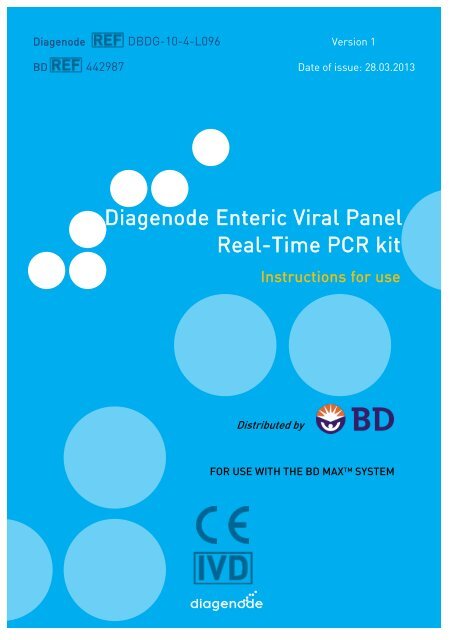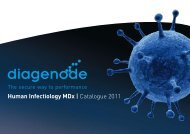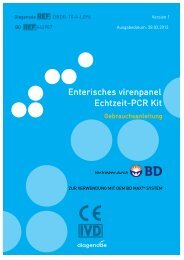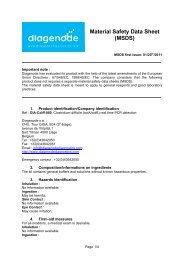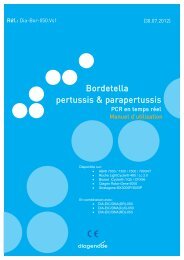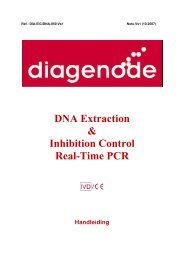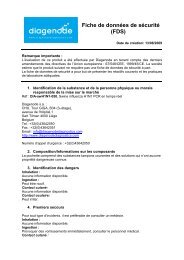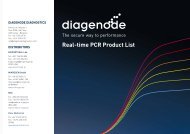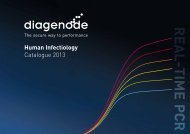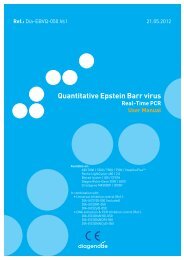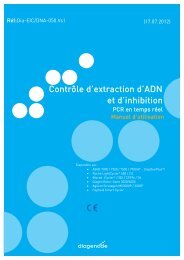Diagenode Enteric Viral Panel Real-Time PCR kit
Diagenode Enteric Viral Panel Real-Time PCR kit
Diagenode Enteric Viral Panel Real-Time PCR kit
You also want an ePaper? Increase the reach of your titles
YUMPU automatically turns print PDFs into web optimized ePapers that Google loves.
DIAGENODE <strong>Enteric</strong> <strong>Viral</strong> <strong>Panel</strong> <strong>Real</strong> <strong>Time</strong> <strong>PCR</strong> <strong>kit</strong> INSTRUCTIONS FOR USE<br />
<strong>Diagenode</strong> DBDG-10-4-L096 Version 1<br />
BD 442987 Date of issue: 28.03.2013<br />
<strong>Diagenode</strong> <strong>Enteric</strong> <strong>Viral</strong> <strong>Panel</strong><br />
<strong>Real</strong>-<strong>Time</strong> <strong>PCR</strong> <strong>kit</strong><br />
Instructions for use<br />
Distributed by<br />
FOR USE WITH THE BD MAX TM SYSTEM
<strong>Diagenode</strong> sa / CHU - Tour GIGA - B34 – 3 rd Floor // Avenue de l’Hôpital, 1 // 4000 Liège (Sart Tilman) // Belgium // Phone: (+32) 4 364 20 50<br />
// Mail: info@diagenode.com<br />
Page | 1
DIAGENODE <strong>Enteric</strong> <strong>Viral</strong> <strong>Panel</strong> <strong>Real</strong> <strong>Time</strong> <strong>PCR</strong> <strong>kit</strong> INSTRUCTIONS FOR USE<br />
Contents<br />
1. INTRODUCTION ............................................................................................................................... 3<br />
2. GENERAL INFORMATION................................................................................................................. 4<br />
2.1 INTENDED USE ................................................................................................................................... 4<br />
2.2 PATHOGEN INFORMATION ................................................................................................................... 4<br />
2.3 CONTENTS OF KIT .............................................................................................................................. 4<br />
3. MATERIAL ....................................................................................................................................... 5<br />
3.1 MATERIAL REQUIRED (NOT PROVIDED) ................................................................................................. 5<br />
3.2 EQUIPMENT AND MATERIAL IN COMBINATION WITH DIAGENODE ENTERIC VIRAL PANEL REAL-TIME <strong>PCR</strong> KIT (NOT<br />
PROVIDED) ......................................................................................................................................... 5<br />
4. VALIDATION .................................................................................................................................... 5<br />
5. QUALITY CONTROL .......................................................................................................................... 6<br />
6. REAGENTS STORAGE, HANDLING AND STABILITY .......................................................................... 6<br />
7. SAMPLES COLLECTION, STORAGE AND TRANSPORT ...................................................................... 7<br />
7.1 SAMPLE COLLECTION TYPE ................................................................................................................. 7<br />
7.2 SAMPLE STORAGE .............................................................................................................................. 7<br />
7.3 SAMPLE TRANSPORT .......................................................................................................................... 7<br />
8. WARNINGS AND PRECAUTIONS ...................................................................................................... 8<br />
9. PROTOCOL ...................................................................................................................................... 9<br />
9.1 SAMPLE AND CONTROL PREPARATION .................................................................................................. 9<br />
9.2 RT-<strong>PCR</strong> MIX PREPARATION ............................................................................................................... 9<br />
9.3 BD MAX TM SYSTEM AMPLIFICATION ................................................................................................... 10<br />
10. RESULTS ..................................................................................................................................... 13<br />
11. TROUBLESHOOTING GUIDE ......................................................................................................... 14<br />
12. PERFORMANCE CHARACTERISTICS ............................................................................................ 15<br />
12.1 ANALYTICAL SENSITIVITY ................................................................................................................. 15<br />
12.2 PRECISION .................................................................................................................................... 15<br />
12.3 ANALYTICAL SPECIFICITY ................................................................................................................. 16<br />
12.4 CLINICAL PERFORMANCE ................................................................................................................ 17<br />
13. TEST LIMITATIONS ...................................................................................................................... 18<br />
14. QUALITY CERTIFICATION ............................................................................................................. 18<br />
15. REFERENCES .............................................................................................................................. 19<br />
16. EXPLANATION OF SYMBOLS ........................................................................................................ 20<br />
17. NOTICE TO PURCHASER .............................................................................................................. 21
Page | 3<br />
1. Introduction<br />
<strong>Real</strong>-time polymerase chain reaction, also called quantitative real-time polymerase chain reaction<br />
(q<strong>PCR</strong>), is a nucleic acid technology used to detect and quantify specific DNA sequences.<br />
This quantification can be measured in absolute or relative number of copies.<br />
<strong>Real</strong>-time <strong>PCR</strong> technology allows rapid, specific, and quantitative measurements of the presence of<br />
genes involved in infectious diseases, cancer, and genetic abnormalities.<br />
This powerful technology is used in <strong>Diagenode</strong>'s <strong>kit</strong>s for accurate pathogen detection for a number of<br />
diseases.<br />
One of the prominent attributes of q<strong>PCR</strong> technology is that amplified DNA is quantified as it accumulates<br />
in the reaction in "real-time" for each <strong>PCR</strong> amplification cycle, allowing for far more accurate<br />
measurements than with traditional end-point <strong>PCR</strong>. These real-time measurements are made possible<br />
by quantifying signals from fluorescent dyes that intercalate with the double-stranded DNA produced in<br />
each amplification cycle. Alternatively, one can use labeled DNA oligonucleotide probes with a dye (e.g. a<br />
TaqMan® probe) that subsequently hybridize with the complementary DNA to allow real-time<br />
measurements during q<strong>PCR</strong>. The resulting fluorescent signals can be closely monitored and quantified<br />
using an instrument such as a thermal cycler adapted for q<strong>PCR</strong>.<br />
Figure 1: Technology using dual-labeled hydrolysis probes<br />
Figure 2: Specific hybridization of primers and probes to the target gene.<br />
Figure 3: Elongation and release of reporter dye by Taq polymerase.<br />
<strong>Diagenode</strong> sa / CHU - Tour GIGA - B34 – 3 rd Floor // Avenue de l’Hôpital, 1 // 4000 Liège (Sart Tilman) // Belgium // Phone: (+32) 4 364 20 50<br />
// Mail: info@diagenode.com
DIAGENODE <strong>Enteric</strong> <strong>Viral</strong> <strong>Panel</strong> <strong>Real</strong> <strong>Time</strong> <strong>PCR</strong> <strong>kit</strong> INSTRUCTIONS FOR USE<br />
2. General Information<br />
2.1 Intended use<br />
The <strong>Diagenode</strong> <strong>Enteric</strong> <strong>Viral</strong> <strong>Panel</strong> <strong>Real</strong>-<strong>Time</strong> <strong>PCR</strong> <strong>kit</strong> as implemented on the BD MAX System is an<br />
automated in vitro diagnostic test for the qualitative detection of Norovirus (genogroups I and II) and<br />
Rotavirus species in stool specimens obtained from patients with signs and symptoms of gastroenteritis.<br />
The detection of Norovirus and Rotavirus nucleic acid from symptomatic patient aids in the diagnosis of<br />
suspected gastro-enteric infections. This test is not intended to differentiate the Norovirus genogroups.<br />
<strong>Viral</strong> nucleic acid is extracted from the specimen, which undergoes reverse transcription to generate<br />
complementary DNA (cDNA). The target cDNA is amplified using q<strong>PCR</strong> and then analyzed to detect the<br />
presence or absence of each virus in the panel.<br />
2.2 Pathogen information<br />
Rotavirus is the most common cause of severe diarrhea among infants and young children (1), and is one<br />
of several viruses that cause infections often called stomach flu, despite having no relation to influenza.<br />
It is a genus of double-stranded RNA virus in the family Reoviridae. By the age of five, nearly every child<br />
in the world has been infected with rotavirus at least once (2). However, with each infection, immunity<br />
develops, subsequent infections are less severe (3), and adults are rarely affected (4). There are five<br />
species of this virus, referred to as A, B, C, D, and E. Rotavirus A, the most common, causes more than<br />
90% of infections in humans.<br />
Norovirus is an RNA virus that causes approximately 90% of epidemic non-bacterial outbreaks of<br />
gastroenteritis around the world (5), and may be responsible for 50% of all foodborne outbreaks of<br />
gastroenteritis in the US (6). Norovirus I and II are the both genogroups the most important in human and<br />
affects people of all ages. The viruses are transmitted by faecally contaminated food or water, by<br />
person-to-person contact (7) and via aerosolization of the virus and subsequent contamination of surfaces<br />
(8).<br />
2.3 Contents of <strong>kit</strong><br />
This <strong>kit</strong> is used with the BD MAX TM System.<br />
<strong>Diagenode</strong> <strong>Enteric</strong> <strong>Viral</strong> <strong>Panel</strong> <strong>Real</strong>-<strong>Time</strong> <strong>PCR</strong> <strong>kit</strong>: 96 <strong>PCR</strong> reactions (12,5 µL <strong>PCR</strong> volume), one box :<br />
I. <strong>Enteric</strong> <strong>Viral</strong> <strong>Panel</strong> and internal control RNA double-dye probe & primers (4 tubes):<br />
<strong>Enteric</strong> <strong>Viral</strong> <strong>Panel</strong> double-dye probe & primers with Noro I (FAM, 520 nm), Noro II (YD, 549 nm),<br />
Rota (TR, 603 nm), and RNA extraction & inhibition control double-dye probe & primers (Cy5, 662<br />
nm): 65 µL each, red tubes.<br />
II. <strong>Enteric</strong> <strong>Viral</strong> <strong>Panel</strong> positive control: 120 µL, green tube.<br />
III. <strong>Enteric</strong> <strong>Viral</strong> <strong>Panel</strong> negative control (H2O <strong>PCR</strong> grade): 120 µL, sky blue tube.<br />
IV. H2O <strong>PCR</strong> grade: 500 µL, sky blue tube.<br />
V. Optima PLUS Master Mix: 720 µL, white tube<br />
VI. RNA virus culture inactivated (internal control): 1000 µL, yellow tube
Page | 5<br />
3. Material<br />
3.1 Material required (Not provided)<br />
• Phosphate buffered saline (PBS)<br />
• Microcentrifuge<br />
• Pipettes (accurate between 1-1000 µL)<br />
• Sterile pipette tips with filters<br />
• Powder-free gloves<br />
• Vortex mixer<br />
• Lab coat<br />
• RNase/DNase-free microcentrifuge tubes (1.5 and/or 2 mL)<br />
• RNase/DNase free water<br />
• Laminar flow hood<br />
• A sterile and crew-cap container for the collection of stool samples<br />
• Stopwatch or timer<br />
• Precision balance<br />
3.2 Equipment and material in combination with <strong>Diagenode</strong> <strong>Enteric</strong> <strong>Viral</strong> <strong>Panel</strong> <strong>Real</strong>-<strong>Time</strong><br />
<strong>PCR</strong> <strong>kit</strong> (Not provided)<br />
• <strong>Real</strong>-time <strong>PCR</strong> instrument: BD MAX System (Ref: 441916)<br />
• BD MAX RNA extraction <strong>kit</strong> RNA-3 (Ref : 437522): RNA Extraction Reagent (E2-R)<br />
RNA Sample Preparation Reagent (SP2-R)<br />
DNase Reagent (D1)<br />
RNA Unitized Reagent Strips<br />
• BD MAX <strong>PCR</strong> Cartridges (Ref : 437519)<br />
4. Validation<br />
<strong>Diagenode</strong> <strong>Enteric</strong> <strong>Viral</strong> <strong>Panel</strong> <strong>Real</strong>-<strong>Time</strong> <strong>PCR</strong> <strong>kit</strong> has been validated on the parameters as described<br />
below:<br />
Collected samples<br />
<strong>PCR</strong> platform<br />
Stools<br />
BD MAX TM System<br />
<strong>Diagenode</strong> sa / CHU - Tour GIGA - B34 – 3 rd Floor // Avenue de l’Hôpital, 1 // 4000 Liège (Sart Tilman) // Belgium // Phone: (+32) 4 364 20 50<br />
// Mail: info@diagenode.com
DIAGENODE <strong>Enteric</strong> <strong>Viral</strong> <strong>Panel</strong> <strong>Real</strong> <strong>Time</strong> <strong>PCR</strong> <strong>kit</strong> INSTRUCTIONS FOR USE<br />
5. Quality Control<br />
• Quality Control requirements must be performed in conformance with local, state and/or federal<br />
regulations or accreditation requirements and your laboratory’s standard quality control procedures.<br />
• Quality control procedures are intended to monitor reagent and assay performance.<br />
Control type<br />
Positive<br />
Negative<br />
Internal<br />
For monitoring the following reagents and assay performance<br />
Substantial reagent failure including primer and probe integrity<br />
Reagent and/or environmental contamination<br />
Failure in lysis and extraction procedure<br />
<strong>PCR</strong> inhibition in individual samples and reagent failure or process error<br />
• Test all positive control and the internal control prior to running samples with each new <strong>kit</strong> lot to<br />
ensure all reagents and <strong>kit</strong> components are working properly.<br />
• Good laboratory practice recommends including the internal control in each nucleic acid isolation<br />
run. The internal control should be treated as a sample.<br />
• Never run the positive control through nucleic acid isolation.<br />
• Inclusion of one negative control and at least one positive control is recommended in each<br />
amplification / detection run performed.<br />
• Failure of controls invalidates the run and results should not be reported.<br />
- If the positive control is not positive within the specified Ct range but the negative control is valid,<br />
repeat testing should be done starting from the original sample and using new aliquot of the<br />
positive control. If repeat results are still invalid, results should not be reported and testing<br />
should be repeated from a new sample should be collected and tested.<br />
- If the internal control is not positive within the specified Ct range or the negative control is invalid,<br />
repeat testing should be done starting from the original sample using a new internal control and a<br />
new negative control. If repeat results are still invalid, results should not be reported and a new<br />
sample should be collected and tested (see point 11. Troubleshooting Guide).<br />
6. Reagents Storage, Handling and Stability<br />
Store all reagents (opened and unopened) at ≤ -20°C until the expiry date as defined below:<br />
Condition Storage temperature Stability<br />
Unopened reagent ≤ -20°C Expiry date stated on the label<br />
Always check the expiry date on the reagent labels.<br />
We recommend not exposing to more than 6 freeze-thaw cycles to avoid the degradation of compounds.<br />
<strong>Diagenode</strong> <strong>Enteric</strong> <strong>Viral</strong> <strong>Panel</strong> <strong>Real</strong>-<strong>Time</strong> <strong>PCR</strong> <strong>kit</strong> is shipped frozen, should arrive frozen and should be<br />
stored frozen at ≤-20°C after receipt. If the <strong>kit</strong> contents are not frozen, contact your local BD<br />
representative.<br />
Protect reagents from light.<br />
Caution<br />
Storage of the <strong>kit</strong> at room temperature can lead to the degradation of the <strong>kit</strong>s components. This will lead<br />
to a decreased sensitivity and we would strongly advise using a new <strong>kit</strong>.
Page | 7<br />
7. Samples Collection, Storage and Transport<br />
7.1 Sample Collection Type<br />
The <strong>PCR</strong> test is performed using liquid or soft stool samples.<br />
Standard collection procedures are appropriate to obtain raw stool. Raw stool should be placed in a<br />
sterile and screw-cap container that can be adequately sealed.<br />
7.2 Sample Storage<br />
Stool samples must be stored at 2 to 8°C for up to 24 hours or frozen at -20°C or -70°C for storage<br />
longer than 24 hours.<br />
Stool samples should be stored in sterile and screw-cap container.<br />
The sensitivity of the <strong>PCR</strong> could be reduced through repeated freezing and thawing of stool samples;<br />
therefore, avoid freeze/thaw cycles.<br />
7.3 Sample Transport<br />
Stool samples must be transported in dry sterile container.<br />
The samples must be transported following the local and national regulations for the transport of<br />
etiologic agent.<br />
In order to avoid degradation of nucleic acid, we advise shipping at -20°C if transport time is more than<br />
24 hours.<br />
In the laboratory, samples may be transported at room temperature.<br />
<strong>Diagenode</strong> sa / CHU - Tour GIGA - B34 – 3 rd Floor // Avenue de l’Hôpital, 1 // 4000 Liège (Sart Tilman) // Belgium // Phone: (+32) 4 364 20 50<br />
// Mail: info@diagenode.com
DIAGENODE <strong>Enteric</strong> <strong>Viral</strong> <strong>Panel</strong> <strong>Real</strong> <strong>Time</strong> <strong>PCR</strong> <strong>kit</strong> INSTRUCTIONS FOR USE<br />
8. Warnings and Precautions<br />
If you receive a damaged parcel or thawed <strong>kit</strong>s, please contact our local BD<br />
representative. Do not use the <strong>kit</strong>.<br />
General information<br />
• Read all instruction before performing the experiment.<br />
• Use of this product should be limited to personnel who have been trained in the techniques of <strong>Real</strong>-<br />
<strong>Time</strong> <strong>PCR</strong>.<br />
• For in vitro diagnostic use.<br />
• This assay is for use with liquid or soft raw stool specimens.<br />
Precautions<br />
• Do not use the <strong>kit</strong> if the label that seals the outer box is broken.<br />
• Do not use reagents if the protective box is open or torn upon arrival.<br />
• Do not use reagents if the tube has been opened or damaged.<br />
• Do not mix reagents from different <strong>kit</strong>s and/or lots.<br />
• Do not use expired reagents and/or materials.<br />
• Do not mix caps between tubes or re-use caps as contamination may occur and compromise<br />
test results.<br />
• Aerosol resistant tips must be used for all <strong>PCR</strong> mixtures.<br />
• Performing the assay outside of the recommended time ranges may produce invalid<br />
results. Assays not performed within specified time ranges should be repeated.<br />
• The <strong>PCR</strong> laboratory (safety cabinet, DNA/ RNA extraction platform, bench coat, etc.) must be cleaned<br />
after each <strong>PCR</strong> experiment with appropriate solutions.<br />
• Additional controls may be tested according to guidelines or requirements of local,<br />
state, provincial and/or federal regulations or accrediting organizations.<br />
• In cases where other <strong>PCR</strong> tests are conducted in the same general area of the laboratory, care must<br />
be taken to ensure that the <strong>Diagenode</strong> <strong>Enteric</strong> <strong>Viral</strong> panel <strong>Real</strong> <strong>Time</strong> <strong>PCR</strong> <strong>kit</strong>, BD MAX RNA<br />
Extraction <strong>kit</strong> RNA-3, any additional reagents required for testing, and the BD MAX System are not<br />
contaminated. Gloves must be changed before manipulating reagents and cartridges.<br />
• Discard the <strong>kit</strong> with a suspected contamination.<br />
• Always handle specimens as if they are infectious and in accordance with safe<br />
laboratory procedure such as those described in local legislation documentation.<br />
• Wear protective clothing and disposable gloves while handling <strong>kit</strong> reagents. Wash and disinfect hands<br />
thoroughly after performing the test.<br />
• The <strong>kit</strong> should not be used by somebody displaying symptoms of the disease being detected by<br />
the <strong>kit</strong>.<br />
• Do not pipette by mouth.<br />
• Do not ingest any components from the <strong>kit</strong>.<br />
• Do not smoke, drink, or eat in areas where specimens or <strong>kit</strong> reagents are being handled.<br />
• The experiments should not be carried out during pregnancy due to risks to the newborn baby.<br />
• Dispose of unused reagents and waste in accordance with country, federal, provincial, state and local<br />
regulations.
Page | 9<br />
9. Protocol<br />
Collect specimen and label appropriately (see point 7.1 Samples Collection Type)<br />
9.1 Sample and control preparation<br />
9.1.1 Sample pretreatement<br />
• Weigh 100 mg of stool samples with a precision balance.<br />
• Add 1 mL PBS to 100 mg of stool.<br />
• Vortex for 1 minute.<br />
• Allow mixture to rest for 10 minutes at room temperature.<br />
• Vortex for another 1 minute.<br />
• Centrifuge at 1500 rpm for 15 seconds.<br />
• Dilute the supernatant 1/10 in PBS.<br />
• Pipette 500 µL of the supernatant and pipette 10 µL of RNA internal control ( yellow tube)<br />
into one Sample Preparation Reagent tube.<br />
• Close each Sample Preparation Reagent tube and vortex for 10 seconds.<br />
9.1.2 <strong>Diagenode</strong> negative and positive control preparation (optional)<br />
To validate the run and for result interpretation, you need to perform a positive and negative control:<br />
• For the positive control:<br />
Pipette 10 µL of RNA internal control (yellow tube) and 500 µL of RNase/DNase free water into<br />
one Sample Preparation Reagent tube. Re-cap the tube, vortex, and un-cap the tube prior to use.<br />
• For the negative control:<br />
Pipette 10 µL of <strong>Diagenode</strong> negative control (sky blue tube), 10 µL of RNA internal control (yellow<br />
tube) and 490 µL of RNase/DNase free water into one Sample Preparation Reagent tube. Re-cap<br />
the tube, vortex, and un-cap the tube prior to use.<br />
9.2 RT-<strong>PCR</strong> Mix preparation<br />
1. Count the total number of samples and controls to be tested in one run.<br />
2. Shortly before running the assay, prepare the following complete master mix by multiplying each<br />
component volume by the total number of samples, plus 20% overage accounting for pipetting errors<br />
(see table below).<br />
Optima PLUS Master Mix (white tube) ……………………………….6.75 µL<br />
<strong>Enteric</strong> <strong>Viral</strong> panel primers and probes (red tube) ………………2.5 µL<br />
H2O <strong>PCR</strong> grade (sky blue tube) ….………………………………………3.25 µL<br />
Final volume for one strip: ………………………………..……… 12.5 µL<br />
<strong>Diagenode</strong> sa / CHU - Tour GIGA - B34 – 3 rd Floor // Avenue de l’Hôpital, 1 // 4000 Liège (Sart Tilman) // Belgium // Phone: (+32) 4 364 20 50<br />
// Mail: info@diagenode.com
DIAGENODE <strong>Enteric</strong> <strong>Viral</strong> <strong>Panel</strong> <strong>Real</strong> <strong>Time</strong> <strong>PCR</strong> <strong>kit</strong> INSTRUCTIONS FOR USE<br />
Example of calculation for several strips/reactions:<br />
Number of<br />
samples<br />
Percentage<br />
error of<br />
pipetting<br />
Primers/Probe<br />
(µL)<br />
Optima PLUS<br />
Master Mix<br />
(µL)<br />
H 2 O<br />
(<strong>PCR</strong> grade)<br />
(µL)<br />
Total<br />
(µL)<br />
3 20% 9 24.3 11.7 45.0<br />
4 20% 12 32.4 15.6 60.0<br />
5 20% 15 40.5 19.5 75.0<br />
6 20% 18 48.6 23.4 90.0<br />
7 20% 21 56.7 27.3 105.0<br />
8 20% 24 64.8 31.2 120.0<br />
9 20% 27 72.9 35.1 135.0<br />
10 20% 30 81.0 39.0 150.0<br />
11 20% 33 89.1 42.9 165.0<br />
12 20% 36 97.2 46.8 180.0<br />
13 20% 39 105.3 50.7 195.0<br />
14 20% 42 113.4 54.7 210.1<br />
15 20% 45 121.5 58.6 225.1<br />
16 20% 48 129.6 62.5 240.1<br />
17 20% 51 137.7 66.4 255.1<br />
18 20% 54 145.8 70.3 270.1<br />
19 20% 57 153.9 74.2 285.1<br />
20 20% 60 162.0 78.1 300.1<br />
21 20% 63 170.1 82.0 315.1<br />
22 20% 66 178.2 85.9 330.1<br />
23 20% 69 186.3 89.8 345.1<br />
24 20% 72 194.4 93.7 360.1<br />
9.3 BD MAX TM System amplification<br />
Note: Refer to the BD MAX System User’s Manual for detailed instructions.<br />
9.3.1 Creating <strong>PCR</strong> test for <strong>Diagenode</strong> EVP (<strong>Enteric</strong> <strong>Viral</strong> <strong>Panel</strong>)<br />
Note: If you already have created the <strong>Diagenode</strong> EVP test, you can skip step 9.3.1 and go directly to<br />
9.3.2.<br />
1. On the « Run » screen of the BD MAX TM System, select the « Test Editor » tab<br />
2. Click the « Create Test » button.<br />
3. In the « Test Name » window, name your test: <strong>Diagenode</strong> EVP.<br />
4. In the « Extraction Type » drop down menu, select RNA-3.<br />
5. In the « Master Mix Format » drop down menu, choose« Research MM, Probes/Primers Add<br />
Manually ».
Page | 11<br />
6. In « Channel Settings », set « Gains » and « Threshold » as follow :<br />
Channel<br />
475/520<br />
530/565<br />
585/630<br />
630/665<br />
680/715<br />
7. In « GuardRail », select « Default »<br />
8. In « Test Details », enter the <strong>PCR</strong> profile :<br />
Gain<br />
40<br />
60<br />
60<br />
60<br />
0<br />
Threshold<br />
150<br />
250<br />
300<br />
150<br />
/<br />
New Step<br />
Cycle<br />
1<br />
Type<br />
Profile type<br />
<strong>Time</strong> (s)<br />
1800.0<br />
Hold<br />
Temp (°C)<br />
50.3<br />
Detect<br />
<br />
New Step<br />
Cycle<br />
1<br />
Type<br />
Profile type<br />
<strong>Time</strong> (s)<br />
600.0<br />
Hold<br />
Temp (°C)<br />
95.0<br />
Detect<br />
<br />
New Step<br />
Cycle<br />
45<br />
Type<br />
Profile type<br />
<strong>Time</strong> (s)<br />
30.1<br />
30.0<br />
30.0<br />
3-Temperature<br />
Temp (°C)<br />
95.0<br />
55.0<br />
68.0<br />
Detect<br />
<br />
<br />
<br />
9. Click the « Spectral Cross Talk » tab and enter the following parameters:<br />
Excitation<br />
Channel<br />
False Receiving Channel<br />
475/520 530/565 585/630 630/665 680/715<br />
475/520 2.1 0.0 0.0 0.0<br />
530/565 1.2 0.0 0.0 0.0<br />
585/630 0.0 0.3 2.7 0.0<br />
630/665 0.0 0.0 4.9 0.0<br />
680/715 0.0 0.0 0.0 4.7<br />
10. Click the « Save Test » button.<br />
<strong>Diagenode</strong> sa / CHU - Tour GIGA - B34 – 3 rd Floor // Avenue de l’Hôpital, 1 // 4000 Liège (Sart Tilman) // Belgium // Phone: (+32) 4 364 20 50<br />
// Mail: info@diagenode.com
DIAGENODE <strong>Enteric</strong> <strong>Viral</strong> <strong>Panel</strong> <strong>Real</strong> <strong>Time</strong> <strong>PCR</strong> <strong>kit</strong> INSTRUCTIONS FOR USE<br />
9.3.2 BD MAX TM Rack set up<br />
Please refer to BD MAX User’s Manual for additional information.<br />
1. Load the BD MAX racks with the appropriate number of RNA Unitized Reagent Strips (URS).<br />
Gently tap each URS onto a hard surface to ensure that the liquids are at the bottom.<br />
2. Snap the RNA Extraction Reagent tube (white foil) and the DNase Reagent tube (yellow foil) into their<br />
corresponding positions in the URS (see figure 1).<br />
3. Pipette 12.5 μL of Complete Master Mix (prepared in section 9.2) into the snap-in Ready RNA tube<br />
(position 3) of the RNA URS. Make sure there are no bubbles and the liquid is at the bottom of the<br />
tube.<br />
4. For the positive control sample URS, pipette 1 μl of positive control (green tube) into the Ready RNA<br />
tube (position 3) in addition to the Master Mix.<br />
9.3.3 BD MAX TM Instrument set up<br />
1. Select the tab on the screen of the BD MAX System.<br />
2. In the “Assay” drop down menu, select <strong>Diagenode</strong> EPV (if not already created see Section 9.3.1).<br />
3. Enter the Sample Preparation Reagent tube barcode corresponding to each specimen/patient or<br />
control using the barcode scanner or manual entry. Start with Position 1 of Rack A.<br />
4. Place the opened Sample Preparation Reagent tube into its corresponding position in the BD MAX TM<br />
Rack(s).<br />
5. Enter the specimen/patient identification information into the work list, using either the barcode<br />
scanner or manual entry. Continue until all Sample Preparation Reagent tubes are entered. Ensure<br />
that the specimen/patient ID and the Sample Preparation Reagent tubes are accurately matched.<br />
6. Load the rack(s) into the BD MAX TM System (Rack A is positioned on the left side of the BD MAX<br />
System and Rack B on the right side).<br />
7. Load the BD MAX TM <strong>PCR</strong> cartridge(s).<br />
8. Close the BD MAX System door.<br />
9. Click “Start Run”
Page | 13<br />
10. Results<br />
1. In main menu, click the “Results” button.<br />
2. Double click on your run in the list and click on the new tab “Run …..”<br />
3. In the “Print” tab, select: Result <br />
Protocol Details <br />
<strong>PCR</strong> <br />
4. Click on “Create Report” and then on click the “Print Report” button.<br />
Results interpretation with BD MAX TM System software 2.7.4 or 2.7.0<br />
1. For a run to be valid (optional):<br />
a. No BD MAX TM System failures.<br />
b. Negative control has CT value of -1 for all channels except 630/665.<br />
c. Positive control has CT value of 30 ±3.3 for channels 475/520, 530/565, and 585/630.<br />
2. If valid, interpret the specimen results following the chart below:<br />
a. A CT value of 0 indicates that there was no CT value calculated. That sample’s curve must be<br />
reviewed manually with threshold line adjustment to generate a recalculated CT value.<br />
b. A CT value of -1 indicates that no amplification occurred.<br />
c. Any other CT value must be interpreted in correlation with <strong>PCR</strong> curves (“<strong>PCR</strong> Analysis” tab) and<br />
according to the following table:<br />
CT 475/520<br />
Norovirus I<br />
CT 530/565<br />
Norovirus II<br />
CT 585/630<br />
Rotavirus<br />
CT 630/665<br />
Internal Control<br />
Results Interpretation<br />
-1 -1 -1 ≤ 36<br />
Norovirus (I/II) and Rotavirus<br />
RNA Not Detected.<br />
ANY -1 -1 ANY Norovirus (I/II) RNA detected.<br />
Rotavirus RNA Not Detected.<br />
-1 ANY -1 ANY<br />
Norovirus (I/II) RNA detected.<br />
Rotavirus RNA Not Detected.<br />
-1 -1 ANY ANY<br />
Rotavirus RNA detected.<br />
Norovirus (I/II) RNA Not Detected.<br />
ANY ANY -1 ANY<br />
Norovirus (I/II) RNA detected.<br />
Rotavirus RNA Not Detected.<br />
ANY -1 ANY ANY<br />
Norovirus (I/II) and Rotavirus RNA<br />
detected.<br />
-1 ANY ANY ANY<br />
Norovirus (I/II) and Rotavirus RNA<br />
detected.<br />
ANY ANY ANY ANY<br />
Norovirus (I/II) and Rotavirus<br />
RNA detected.<br />
-1 -1 -1<br />
> 36 Inhibitory Specimen*.<br />
Or -1<br />
No diagnosis can be established<br />
from this test.<br />
*For Inhibitory specimens: Repeat test with the original specimen stored at 2-8°C by preparing a new<br />
Sample Preparation Reagent tube from diluted (with PBS) or undiluted specimen. Alternatively, test a<br />
newly collected specimen.<br />
<strong>Diagenode</strong> sa / CHU - Tour GIGA - B34 – 3 rd Floor // Avenue de l’Hôpital, 1 // 4000 Liège (Sart Tilman) // Belgium // Phone: (+32) 4 364 20 50<br />
// Mail: info@diagenode.com
DIAGENODE <strong>Enteric</strong> <strong>Viral</strong> <strong>Panel</strong> <strong>Real</strong> <strong>Time</strong> <strong>PCR</strong> <strong>kit</strong> INSTRUCTIONS FOR USE<br />
11. Troubleshooting guide<br />
Refer to “the troubleshooting” section of the BD MAX TM System User’s Manual for additional information.<br />
Description Possible Causes Corrective Actions<br />
<strong>PCR</strong> inhibited by<br />
exogenous or<br />
endogenous<br />
substances<br />
Repeat sample testing.<br />
Target and internal control do not<br />
amplify.<br />
Target amplifies, but the internal control<br />
does not amplify.<br />
Spike in all amplification curves at same<br />
point.<br />
Very low fluorescence across all<br />
samples, including internal control<br />
Liquid handling<br />
problem<br />
Target out competed<br />
internal control for<br />
resources during<br />
reaction<br />
Power surge<br />
Primer or probe<br />
degradation<br />
Instrument issue<br />
Check URS and Microfluidic<br />
Cartridge to determine where<br />
liquid handling problem<br />
occurred and re-run sample. If<br />
problem persists, contact your<br />
local BD representative<br />
Verify sample has early<br />
amplification.<br />
Verify that system is connected<br />
to the UPS (Uninterruptible Power<br />
Supply).<br />
Check <strong>kit</strong> expiration date and<br />
verify <strong>kit</strong> was stored correctly.<br />
Refer to BD MAX User’s<br />
Manual.<br />
For other trouble shootings/questions, please contact your local BD representative or the<br />
<strong>Diagenode</strong> customer support.
Page | 15<br />
12. Performance Characteristics<br />
12.1 Analytical sensitivity<br />
The analytical detection limit in consideration of the purification (LOD) was assessed for Norovirus I and<br />
II in stool matrix. The analytical detection limit in consideration of the purification is determined using<br />
quantified inactivated Norovirus I and II pathogens. No quantified genomic standard for Rotavirus was<br />
available at the time the analytical sensitivity test was performed. Therefore the LOD for the Rotavirus<br />
has been performed with plasmid DNA directly spiked in the <strong>PCR</strong> Master Mix solution. The number of<br />
copies/reaction was then converted in theoretical copies/ml of sample assuming an extraction efficiency<br />
of 100%.<br />
To determine the analytical sensitivity in consideration of the purification of the <strong>Diagenode</strong> <strong>Enteric</strong> <strong>Viral</strong><br />
<strong>Panel</strong> <strong>Real</strong>-<strong>Time</strong> <strong>PCR</strong> Kit for the detection of Norovirus (I/II) in stool, Norovirus I and Norovirus II dilution<br />
series have been set up in pools of negative stools.<br />
To determine the analytical sensitivity of the <strong>Diagenode</strong> <strong>Enteric</strong> <strong>Viral</strong> <strong>Panel</strong> <strong>Real</strong>-<strong>Time</strong> <strong>PCR</strong> Kit for the<br />
detection of Rotavirus, dilution series of a specific plasmid containing the Rotavirus target sequence<br />
have been set up directly in the <strong>PCR</strong> Master Mix solution.<br />
Samples were analysed on the BD MAX TM Instrument in combination with the <strong>Diagenode</strong> <strong>Enteric</strong> <strong>Viral</strong><br />
<strong>Panel</strong> <strong>Real</strong>-<strong>Time</strong> <strong>PCR</strong> Kit. For Rotavirus, the extraction step was bypassed. Testing was carried out on<br />
different days on 24 replicates. The results were determined by a probit analysis. Analytical sensitivity<br />
(LOD) as defined as the lowest concentration at which ≥ 95% of replicates are tested positive are<br />
presented in the table below.<br />
LOD 95%<br />
Copies/<strong>PCR</strong><br />
Copies/mL<br />
Norovirus I NA 5 151 (312 to 10 000)*<br />
Norovirus II NA 587<br />
Rotavirus 30 397<br />
* The sensitivity of Norovirus I is strongly influenced by the stool specimen.<br />
In the present sensitivity study the LOD ranged from 312 to 10 000 copies/mL<br />
depending of the pool of stool used<br />
12.2 Precision<br />
The precision data of the <strong>Diagenode</strong> <strong>Enteric</strong> <strong>Viral</strong> <strong>Panel</strong> <strong>Real</strong>-<strong>Time</strong> <strong>PCR</strong> Kit have been collected by<br />
means of the BD MAX TM Instrument and allow the determination of the intra-run variability (variability of<br />
multiple results of samples of the same concentration within one experiment) and the inter-run<br />
variability (variability of multiple results of the assay generated by four different runs carried out on<br />
different days) of Norovirus I/II and Rotavirus detection. The data obtained were used to determine the<br />
standard deviation and the coefficient of variation for the pathogens detected.<br />
Precision data for Norovirus I and II have been collected using stool matrix spiked with the<br />
correspondent inactivated pathogens at high and low (closed to the respective LODs) concentrations of<br />
the pathogens. No quantified genomic standard for Rotavirus was available at the time the precision<br />
tests were performed. Therefore precision data for Rotavirus has been collected using plasmid DNA<br />
directly spiked in the <strong>PCR</strong> Master Mix solution at high and low (closed to the LOD) concentrations of<br />
Rotavirus.<br />
Testing was performed by different operators on different days. The precision data were calculated on<br />
basis of the Ct values of the amplification curves as following: intra-assay variation = mean CV of each<br />
<strong>Diagenode</strong> sa / CHU - Tour GIGA - B34 – 3 rd Floor // Avenue de l’Hôpital, 1 // 4000 Liège (Sart Tilman) // Belgium // Phone: (+32) 4 364 20 50<br />
// Mail: info@diagenode.com
DIAGENODE <strong>Enteric</strong> <strong>Viral</strong> <strong>Panel</strong> <strong>Real</strong> <strong>Time</strong> <strong>PCR</strong> <strong>kit</strong> INSTRUCTIONS FOR USE<br />
individual run; inter-assay variation = CV of the mean Ct value of each individual run. Results are<br />
presented in the table below.<br />
Test<br />
Intra-assay Noro I<br />
Inter-assay Noro I<br />
Intra-assay Noro II<br />
Inter-assay Noro II<br />
Intra-assay Rota<br />
Inter-assay Rota<br />
Matrix<br />
Pathogen<br />
Standard Coefficient of<br />
Mean Ct<br />
concentration<br />
deviation 1 variation (%) 2<br />
Stool 312 c/mL 34.6 1.26 3.54<br />
Stool 10 000 c/mL 32.5 0.53 0.85<br />
Stool 312 c/mL 34.6 1.25 3.62<br />
Stool 10 000 c/mL 32.5 2.35 0.67<br />
Stool 2500 c/mL 30.6 0.45 1.46<br />
Stool 625 c/mL 31.5 0.35 1.12<br />
Stool 2500 c/mL 30.6 0.55 1.81<br />
Stool 625 c/mL 31.5 0.43 1.38<br />
NA 532 c/mL 33.3 0.50 1.51<br />
NA 2128 c/mL 31.8 0.25 0.78<br />
NA 532 c/mL 33.3 0.50 1.32<br />
NA 2128 c/mL 31.8 0.31 0.97<br />
1<br />
Values correspond to the mean SD of each individual runs for intra-run variation and to the SD of the<br />
mean Ct value of each individual run for the inter run variation<br />
2<br />
Values correspond to the mean CV of each individual runs for intra-run variation and to the CV of the<br />
mean Ct value of each individual run for the inter run variation<br />
12.3 Analytical specificity<br />
The specificity of the <strong>Diagenode</strong> <strong>Enteric</strong> <strong>Viral</strong> <strong>Panel</strong> <strong>Real</strong>-<strong>Time</strong> <strong>PCR</strong> Kit is first and foremost ensured by<br />
the selection of the primers and probes, as well as the selection of stringent reaction conditions. The<br />
primers and probes were checked for possible homologies to all in gene banks published sequences by<br />
sequence comparison analysis.<br />
To determine the experimental specificity of the <strong>Diagenode</strong> <strong>Enteric</strong> <strong>Viral</strong> <strong>Panel</strong> <strong>Real</strong>-<strong>Time</strong> <strong>PCR</strong> Kit, the<br />
pathogens listed in the following table have been tested for cross-reactivity. None of the tested<br />
pathogens has been reactive.<br />
Pathogens<br />
Bacillus cereus<br />
Campylobacter jejuni<br />
Clostridium difficile<br />
Clostridium perfringens<br />
Cryptosporidium hominis<br />
Cryptosporidium parvum<br />
Entamoeba dispar<br />
Entamoeba histolytica<br />
Enterocytozoon bieneusi<br />
Enterovirus 71<br />
Giardia intestinalis<br />
Human Coxsavirus B4<br />
Human Echovirus 13<br />
Parechovirus 1<br />
Salmonella enterica<br />
Shigella flexneri<br />
Staphylococcus aureus<br />
Yersinia enterocolitica
Page | 17<br />
12.4 Clinical performance<br />
Performance characteristics of the <strong>Diagenode</strong> <strong>Enteric</strong> <strong>Viral</strong> <strong>Panel</strong> <strong>Real</strong>-<strong>Time</strong> <strong>PCR</strong> <strong>kit</strong> were established<br />
during a retrospective study at one reference laboratory in comparison to a validated <strong>PCR</strong> reference<br />
method.<br />
A total of 225 samples (100 negative samples, 25 Norovirus I positive samples, 50 Norovirus-II positive<br />
samples and 50 Rotavirus positive samples) were retrospectively tested with the <strong>Diagenode</strong> <strong>Enteric</strong> <strong>Viral</strong><br />
<strong>Panel</strong> <strong>Real</strong>-<strong>Time</strong> <strong>PCR</strong> <strong>kit</strong> on the BD MAX TM . Samples consisted of 100 mg stool suspended in 0.4 mL<br />
phosphate-buffered saline containing 2% polyvinylpolypyrolidone for the reference method and in 1mL<br />
phosphate-buffered saline for the <strong>Diagenode</strong> <strong>Enteric</strong> <strong>Viral</strong> <strong>Panel</strong> <strong>Real</strong>-<strong>Time</strong> <strong>PCR</strong> <strong>kit</strong>. 200 µL of sample<br />
supernatant were initially extracted on the MagNa-Pure LC, Roche using the TNAI High Performance Kit<br />
(50 µL eluate) and analysed with the Multiplex <strong>Real</strong>-time <strong>PCR</strong> reference method (9) in combination with<br />
the BioRad CFX96 real-time system, the Biorad 5x iScript RT and the Supermix Qiagen 2x HotStar<br />
Mastermix. 500 µL of sample supernatant 1/10 prediluted in PBS were loaded on the BD<br />
MAX TM cartridge. Height invalid samples (no IC detection and no target-specific detection) and one<br />
rotavirus overloaded samples (the software is unable to calculate a Ct value because the viral load is too<br />
high) were excluded from the statistical analysis.<br />
Diagnostic sensitivity, diagnostic specificity and accuracy were calculated for rotavirus and Norovirus<br />
(I/II). Results are summarized in the following tables:<br />
Rotavirus<br />
<strong>Enteric</strong> <strong>Viral</strong> <strong>Panel</strong> <strong>kit</strong><br />
on BD MAX TM<br />
Positive Negative<br />
Norovirus<br />
<strong>Enteric</strong> <strong>Viral</strong> <strong>Panel</strong> <strong>kit</strong> on<br />
BD MAX TM<br />
Positive<br />
(I/II)<br />
Negative<br />
(I/II)<br />
Reference method<br />
Positive<br />
Negative<br />
49 0<br />
7 160<br />
Reference method<br />
Positive<br />
(I/II)<br />
Negative<br />
(I/II)<br />
64<br />
(21/43)<br />
5<br />
(4/1)<br />
6<br />
(0/6)<br />
142<br />
(N/A)<br />
Diagnostic sensitivity (lower Bound 95%CI):<br />
100% (93%) 91% (83%)<br />
Diagnostic specificity (lower Bound 95%CI):<br />
Accuracy:<br />
96% (92%) 97% (92%)<br />
Κ = 0.91<br />
(almost perfect agreement)<br />
Κ = 0.88<br />
(almost perfect agreement)<br />
<strong>Diagenode</strong> sa / CHU - Tour GIGA - B34 – 3 rd Floor // Avenue de l’Hôpital, 1 // 4000 Liège (Sart Tilman) // Belgium // Phone: (+32) 4 364 20 50<br />
// Mail: info@diagenode.com
DIAGENODE <strong>Enteric</strong> <strong>Viral</strong> <strong>Panel</strong> <strong>Real</strong> <strong>Time</strong> <strong>PCR</strong> <strong>kit</strong> INSTRUCTIONS FOR USE<br />
13. Test limitations<br />
• All reagents must exclusively be used for in vitro diagnostics.<br />
• A strict compliance with the user manual is required for optimal results.<br />
• This test has been validated for use with liquid or soft stool samples.<br />
• This test has been validated for use on the BD MAX TM System version 2.7.0 or 2.7.4.<br />
• This test has been validated for the detection of Norovirus and Rotavirus and does not allow<br />
differentiation of Norovirus genogroups.<br />
• Negative results do not preclude infection and should not be used as the sole basis for diagnosis,<br />
treatment or other management decisions.<br />
• The detection of viral nucleic acid is dependent upon proper specimen collection, handling,<br />
transportation, storage and preparation. Failure to observe proper procedures in any one of these<br />
steps can lead to incorrect results. There is a risk of false negative values resulting from improperly<br />
collected, transported or handled samples.<br />
• There is a risk of false negative values due to the presence of sequence variants in the viral targets of<br />
the assay, procedural errors, amplification inhibitors in samples, or inadequate number of organisms<br />
for amplification.<br />
• False negative results may occur due to loss of nucleic acid. The inhibition control has been added to<br />
the test to aid in the identification of samples that contain inhibitors to <strong>PCR</strong> amplification. The control<br />
does not indicate whether or not nucleic acid has been lost due to inadequate collection, transport or<br />
storage of samples.<br />
• There is a risk of false positive values resulting from cross-contamination by target organism, their<br />
nucleic acids or amplified product, or form non-specific signal in the assay.<br />
14. Quality Certification<br />
<strong>Diagenode</strong> has obtained ISO 9001 and ISO 13485 certifications for design, manufacture and sale of IVD<br />
devices using Nucleic Acid technology for infectious diseases.<br />
<strong>Diagenode</strong> <strong>Enteric</strong> <strong>Viral</strong> <strong>Panel</strong> <strong>Real</strong>-<strong>Time</strong> <strong>PCR</strong> <strong>kit</strong> is tested against predetermined specifications to<br />
ensure the product quality.
Page | 19<br />
15. References<br />
(1) Dennehy PH (2000). "Transmission of rotavirus and other enteric pathogens in the home". Pediatr.<br />
Infect. Dis. J. 19 (10 Suppl): S103–5.<br />
(2) Velázquez FR, Matson DO, Calva JJ, Guerrero L, Morrow AL, Carter-Campbell S, Glass RI, Estes MK,<br />
Pickering LK, Ruiz-Palacios GM (1996). "Rotavirus infections in infants as protection against subsequent<br />
infections". N. Engl. J. Med. 335 (14): 1022–8.<br />
(3) Linhares AC, Gabbay YB, Mascarenhas JD, Freitas RB, Flewett TH, Beards GM (1988). "Epidemiology<br />
of rotavirus subgroups and serotypes in Belem, Brazil: a three-year study". Ann. Inst. Pasteur Virol. 139<br />
(1): 89–99.<br />
(4) Bishop RF (1996). "Natural history of human rotavirus infection". Arch. Virol. Suppl. 12: 119–28.<br />
(5) Lindesmith L, Moe C, Marionneau S, et al. (2003). "Human susceptibility and resistance to Norwalk<br />
virus infection". Nat. Med. 9 (5): 548–53.<br />
(6) Widdowson MA, Sulka A, Bulens SN, et al. (2005). "Norovirus and foodborne disease, United States,<br />
1991-2000". Emerging Infect. Dis. 11 (1): 95–102.<br />
(7) Goodgame R (2006). "Norovirus gastroenteritis". Curr Gastroenterol Rep 8 (5): 401–8.<br />
(8) Said MA, Perl TM, Sears CL (November 2008). "Healthcare epidemiology: gastrointestinal flu:<br />
norovirus in health care and long-term care facilities". Clinical Infectious Diseases : an Official<br />
Publication of the Infectious Diseases Society of America 47 (9): 1202–8.<br />
(9) Diagnosis of viral gastroenteritis by simultaneous detection of Adenovirus group F, Astrovirus,<br />
Rotavirus group A, Norovirus genogroups I and II, and Sapovirus in two internally controlled multiplex<br />
real-time <strong>PCR</strong> assays. Noortje M. van Maarseveen1, Els Wessels, Caroline S. de Brouwer, Ann C.T.M.<br />
Vossen, Eric C.J. Claas. Journal of Clinical Virology 49 (2010) 205–210<br />
Noortje M. van Maarseveen, Els Wessels, Caroline S. de Brouwer, Ann C.T.M. Vossen, Eric C.J. Claas<br />
“Diagnosis of viral gastroenteritis by simultaneous detection of Adenovirus group F, Astrovirus,<br />
Rotavirus group A, Norovirus genogroups I and II, and Sapovirus in two internally controlled multiplex<br />
real-time <strong>PCR</strong> assays”. Journal of Clinical Virology 49 (2010) 205–210<br />
S.-Q. Zeng, A. Halkosalo, M. Salminen, E.D. Szakal, L. Puustinen, T. Vesikari.<br />
“One-step quantitative RT-<strong>PCR</strong> for the detection of rotavirus in acute gastroenteritis”.<br />
Journal of Virological Methods 153 (2008) 238–240<br />
Young Bin Park, You-Hee Cho, GwangPyo Ko<br />
“A duplex real-time RT-<strong>PCR</strong> assay for the simultaneous genogroup-specific detection of noroviruses in<br />
both clinical and environmental specimens”. Virus Genes (2011) 43:192–200<br />
<strong>Diagenode</strong> sa / CHU - Tour GIGA - B34 – 3 rd Floor // Avenue de l’Hôpital, 1 // 4000 Liège (Sart Tilman) // Belgium // Phone: (+32) 4 364 20 50<br />
// Mail: info@diagenode.com
DIAGENODE <strong>Enteric</strong> <strong>Viral</strong> <strong>Panel</strong> <strong>Real</strong> <strong>Time</strong> <strong>PCR</strong> <strong>kit</strong> INSTRUCTIONS FOR USE<br />
16. Explanation of symbols<br />
Catalog number<br />
Batch Code<br />
Contains sufficient for tests<br />
Upper limit of temperature<br />
Use by yyyy-mm<br />
In vitro diagnostic medical device<br />
Consult instructions for use<br />
Biological risks<br />
Control<br />
Negative control<br />
Positive control<br />
Keep away from sunlight<br />
Manufacturer
Page | 21<br />
17. Notice to Purchaser<br />
This product is optimized for use in the polymerase chain reaction (<strong>PCR</strong>) covered by patents owned by Roche<br />
Molecular Systems, Inc., and F. Hoffmann-La Roche ltd. (Roche). No license under these patents to use the<br />
<strong>PCR</strong> process is conveyed expressly or by implication to the purchaser by the purchase of this product.<br />
A license to use the <strong>PCR</strong> process for certain research and development activities accompanies the<br />
purchase of certain reagents from licensed suppliers, when used in conjunction with an Authorized<br />
Thermal Cycler, or is available from Applied Biosystems. Further information on purchasing licenses to<br />
practice the <strong>PCR</strong> process may be obtained by contacting the Director of Licensing at Applied Biosystems,<br />
850 Lincoln Center Drive, Foster City, California 94404 or at Roche Molecular Systems, Inc, 1145 Atlantic<br />
Avenue, Alameda, California 94501.<br />
BD MAX TM system is a trademark of Becton, Dickinson and Company.<br />
<strong>Diagenode</strong> sa / CHU - Tour GIGA - B34 – 3 rd Floor // Avenue de l’Hôpital, 1 // 4000 Liège (Sart Tilman) // Belgium // Phone: (+32) 4 364 20 50<br />
// Mail: info@diagenode.com
DIAGENODE <strong>Enteric</strong> <strong>Viral</strong> <strong>Panel</strong> <strong>Real</strong> <strong>Time</strong> <strong>PCR</strong> <strong>kit</strong> INSTRUCTIONS FOR USE<br />
<strong>Diagenode</strong> s.a.<br />
Avenue de l’hôpital,1 • CHU - Tour GIGA - B34 -3rd Floor • 4000 Liège (Sart Tilman)• Belgium<br />
Tel: +32 4 364 20 50 • Fax: +32 4 364 20 51 • info@diagenodediagnostics.com
Page | 23<br />
<strong>Diagenode</strong> sa<br />
CHU, Tour GIGA, B34 3 rd Floor<br />
Avenue de l’hôpital, 1<br />
4000 Liège (Sart Tilman)<br />
BELGIUM<br />
Tel. +32 4 364 20 50<br />
info@diagenodediagnostics.com<br />
www.diagenodediagnostics.com<br />
<strong>Diagenode</strong> sa / CHU - Tour GIGA - B34 – 3 rd Floor // Avenue de l’Hôpital, 1 // 4000 Liège (Sart Tilman) // Belgium // Phone: (+32) 4 364 20 50<br />
// Mail: info@diagenode.com


